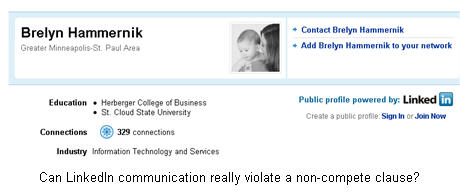LinkedIn, Facebook and non-competes: Where's the line?

If you ping former co-workers on LinkedIn and they wind up working at your new company are you violating terms of a non-compete clause? A lawsuit in Minnesota may shed some light on that question.
TEKsystems, an IT staffing outfit, is suing a former employee for soliciting its contractors and employees to go to a new firm Horizon Integrations.
Computerworld flagged the lawsuit and noted that it’s the first where LinkedIn is the center of a non-compete lawsuit. However, the actual complaint (download PDF) goes beyond LinkedIn connections, which do play a central role in the lawsuit. TEKSystems' complaint against Brelyn Hammernik---and a bevy of others---looks like standard fare except for the LinkedIn connections. The complaint notes:
- Hammernik left TEKsystems in November 2009 and then started communicating with people she knew.
- However, TEKsystems said that Hammernik was taking her knowledge and contacting its workers, contractors and clients with the aim of bringing them on to her new company.
And then the complaint, which spells Hammernik's name wrong in multiple places, continues:
Hammernik is soliciting TEKsystems’ Contract Employees and clients in the geographic area encompassed by the non-competition and non-solicitation provisions of the Hammernik Agreement. For example, Hammernik has communicated with at least 20 of TEKsystems’ Contract Employees using such electronic networking systems as “Linkedin.” Hammernik has, at a minimum, “connected” with the following TEKsystems’ employees through “Linkedin: Harold Osmundson, Steve Wicks, Kazim Merchant, Shawn Faber, Srujana Pasunuri, Shailaja Garishakurti, Kevin Jordahl, Mitha KC, Carl Boudreau, Tom Peterson, Seann Van Cleve, Bob Hasselman, Marcia Diterich, Bill Severson, Claude Wallander, and Brett Snaza. In her contacts with Tom Peterson, Hammernik asked Peterson if he was “still looking for opportunities.” She then stated that she “would love to have [you] come visit my new office and hear about some of the stuff we are working on.”
Beyond LinkedIn, Hammernik allegedly emailed co-workers before she left, told them she was going to Horizon and downloaded information from her work PC. It's notable that the other folks named in the TEKsystems complaint don't have the LinkedIn connections noted. The implication was that Hammernik was a LinkedIn ringleader. The big question is whether you need to be aware of social networking interactions when it comes to non-compete clauses. If you leave a company do you have to defriend people? Will non-compete contracts in the future contain social networking conditions?
Nixon Peabody lawyer Renee Jackson says in a blog post that this lawsuit could have wide ramifications.
Needless to say, Hammernik in a joint response to the complaint denies the allegation (download PDF). She admits that she has LinkedIn connections to the people named, but that they have never been TEKsystems employees. Meanwhile, connections are being questioned. Hammernik said in the response to the complaint:
Defendants further affirmatively state that Claude Wallander, Seann Van Cleve and Tom Peterson initiated contact with Hammernik by inviting her to “Link In” with them and when Hammernik learned of this she provided the information to a TEKsystems recruiter, Elicaseth You. Defendants admit to Hammernik’s communications with Tom Peterson but state that the communications did not relate to staffing or soliciting IT business for Defendant Horizontal Integration.
In addition:
Defendants affirmatively state that TEKsystems’ and its employees’ use of LinkedIn and Facebook for recruiting, promotional or other purposes voids any claim that any information posted therein is trade secret or confidential.
Add all of this up and you have a social networking slippery slope where every connection will be questioned. This spat appears to be headed to a trial. The discovery process is supposed to be completed by Feb. 1, 2011.
